
Whey cheese
Encyclopedia
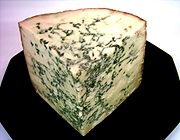
Cheese
Cheese is a generic term for a diverse group of milk-based food products. Cheese is produced throughout the world in wide-ranging flavors, textures, and forms....
, with around 500 different varieties recognised by the International Dairy Federation, over 400 identified by Walter and Hargrove, over 500 by Burkhalter, and over 1,000 by Sandine and Elliker. The varieties may be grouped or classified into types according to criteria such as length of ageing, texture, methods of making, fat content, animal milk, country or region of origin, etc - with these criteria either being used singly or in combination, but with no single method being universally used. The method most commonly and traditionally used is based on moisture content, which is then further narrowed down by fat content and curing or ripening methods. Some attempts have been made to rationalise the classification of cheese - a scheme was proposed by Pieter Walstra which uses the primary and secondary starter combined with moisture content, and Walter and Hargrove suggested classifying by production methods which produces 18 types, which are then further grouped by moisture content.
Moisture: soft to hard
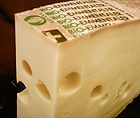
Semi-soft cheeses and the sub-group, Monastery cheeses have a high moisture content and tend to be bland in flavour. Some well-known varieties include Havarti
Havarti
Havarti or Cream Havarti is a semi-soft Danish cow's milk cheese. It is a table cheese that can be sliced, grilled, or melted....
, Munster
Munster (cheese)
Munster or Munster-géromé, is a strong tasting, soft cheese made mainly from milk from the Vosges, between Alsace, Lorraine and Franche-Comté in France....
and Port Salut.
Cheeses that range in texture from semi-soft to firm include Swiss-style cheeses such as Emmental
Emmental (cheese)
Emmental or Emmentaler is a cheese from Switzerland. It is sometimes known as Swiss cheese in North America, Australia and New Zealand, although Swiss cheese does not always imply Emmentaler....
and Gruyère
Gruyère (cheese)
Gruyère is a hard yellow cheese, named after the town of Gruyères in Switzerland, and originated in the cantons of Fribourg, Vaud, Neuchâtel, Jura, and Berne...
. The same bacteria that give such cheeses their eyes
Eyes (cheese)
Eyes are the round holes that are a characteristic feature of Swiss-type cheese and some Dutch-type cheeses. They are bubbles of carbon dioxide gas that is produced by bacteria in the cheese....
also contribute to their aromatic and sharp flavours. Other semi-soft to firm cheeses include Gouda
Gouda (cheese)
Gouda is an orange cheese made from cow's milk. The cheese is named after the city of Gouda in the Netherlands, but its name is not protected. However, the European Commission has confirmed that "Gouda Holland" is to be protected...
, Edam, Jarlsberg
Jarlsberg cheese
Jarlsberg is a mild cow's-milk cheese with large irregular holes or what are commonly referred to as "eyes", originating in Jarlsberg, Norway.-Description:...
and Cantal
Cantal (cheese)
Cantal cheese is a firm cheese from the Cantal region of France. It is named after the Cantal mountains in the Auvergne region.One of the oldest cheeses in France, Cantal dates back to the times of the Gauls. It came to prominence when marshal Henri de La Ferté-Senneterre served it at the table of...
. Cheeses of this type are ideal for melting and are often served on toast
Toast
Toast is bread that has been browned by exposure to radiant heat. This browning reaction is known as the Maillard reaction. Toasting warms the bread and makes it firmer, so it holds toppings more securely...
for quick snacks or simple meals.
Harder cheeses have a lower moisture content than softer cheeses. They are generally packed into moulds under more pressure and aged for a longer time than the soft cheeses. Cheeses that are classified as semi-hard to hard include the familiar Cheddar
Cheddar cheese
Cheddar cheese is a relatively hard, yellow to off-white, and sometimes sharp-tasting cheese, produced in several countries around the world. It has its origins in the English village of Cheddar in Somerset....
, originating in the village of Cheddar
Cheddar
Cheddar is a large village and civil parish in the Sedgemoor district of the English county of Somerset. It is situated on the southern edge of the Mendip Hills, north-west of Wells. The civil parish includes the hamlets of Nyland and Bradley Cross...
in England
England
England is a country that is part of the United Kingdom. It shares land borders with Scotland to the north and Wales to the west; the Irish Sea is to the north west, the Celtic Sea to the south west, with the North Sea to the east and the English Channel to the south separating it from continental...
but now used as a generic term for this style of cheese, of which varieties are imitated worldwide and are marketed by strength or the length of time they have been aged.
Cheddar is one of a family of semi-hard or hard cheeses (including Cheshire
Cheshire cheese
Cheshire cheese is a dense and crumbly cheese produced in the English county of Cheshire, and four neighbouring counties, two in Wales and two in England .-History:...
and Gloucester) whose curd is cut, gently heated, piled, and stirred before being pressed into forms. Colby
Colby cheese
-History:Joseph F. Steinwand in 1874 developed a new type of cheese at his father's cheese factory near Colby, Wisconsin. The cheese was named after the village, which had been founded three years earlier....
and Monterey Jack
Monterey Jack
Monterey Jack is an American semihard cheese made using cow's milk. It is commonly sold by itself, or mixed with Colby to make a marbled cheese known as Colby-Jack . Cheddar-Jack varieties are also available....
are similar but milder cheeses; their curd is rinsed before it is pressed, washing away some acidity and calcium
Calcium
Calcium is the chemical element with the symbol Ca and atomic number 20. It has an atomic mass of 40.078 amu. Calcium is a soft gray alkaline earth metal, and is the fifth-most-abundant element by mass in the Earth's crust...
. A similar curd-washing takes place when making the Dutch
Netherlands
The Netherlands is a constituent country of the Kingdom of the Netherlands, located mainly in North-West Europe and with several islands in the Caribbean. Mainland Netherlands borders the North Sea to the north and west, Belgium to the south, and Germany to the east, and shares maritime borders...
cheeses Edam and Gouda
Gouda (cheese)
Gouda is an orange cheese made from cow's milk. The cheese is named after the city of Gouda in the Netherlands, but its name is not protected. However, the European Commission has confirmed that "Gouda Holland" is to be protected...
.
Hard cheeses — "grating cheeses" such as Parmesan and Pecorino Romano
Pecorino Romano
Pecorino Romano is a hard, salty Italian cheese, suitable primarily for grating, made out of sheep milk . Pecorino Romano was produced in Latium up to 1884 when, due to the prohibition issued by the city council of salting the cheese inside their shops in Rome, many producers moved to the island of...
—are quite firmly packed into large forms and aged for months or years.
Fresh, whey and stretched curd cheeses
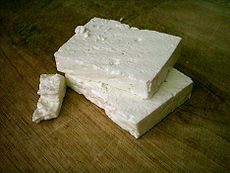
Preservative
A preservative is a naturally occurring or synthetically produced substance that is added to products such as foods, pharmaceuticals, paints, biological samples, wood, etc. to prevent decomposition by microbial growth or by undesirable chemical changes....
s can spoil in a matter of days.
For these simplest cheeses, milk is curdled and drained, with little other processing. Examples include cottage cheese
Cottage cheese
Cottage cheese is a cheese curd product with a mild flavor. It is drained, but not pressed, so some whey remains and the individual curds remain loose. The curd is usually washed to remove acidity, giving sweet curd cheese. It is not aged or colored. Different styles of cottage cheese are made from...
, Romanian Caş, Neufchâtel
Neufchâtel (cheese)
French Neufchâtel is a soft, slightly crumbly, mould-ripened cheese made in the region of Normandy. One of the oldest cheeses in France, its production is believed to date back to the 6th century. It looks similar to Camembert, with a dry, white, edible rind, but the taste is saltier and sharper....
(the model for American-style cream cheese
Cream cheese
Cream cheese is a soft, mild-tasting, white cheese with a high fat content. Traditionally, it is made from unskimmed milk enriched with additional cream....
), and fresh goat's milk chèvre
Chèvre cheese
Goat cheese, or chèvre , is cheese made out of the milk of goats.-Properties:Although cow's milk and goat's milk have similar overall fat contents, the higher proportion of medium-chain fatty acids such as caproic, caprylic and capric acid in goat's milk contributes to the characteristic tart...
. Such cheeses are soft and spreadable, with a mild flavour.
Whey cheeses are fresh cheeses made from the whey
Whey
Whey or Milk Serum is the liquid remaining after milk has been curdled and strained. It is a by-product of the manufacture of cheese or casein and has several commercial uses. Sweet whey is manufactured during the making of rennet types of hard cheese like cheddar or Swiss cheese...
, which would otherwise be discarded, while producing other cheeses. Provençal Brousse, Corsican Brocciu
Brocciu
Brocciu is a whey cheese produced from sheep milk or goat milk. This is notable as a substitute for lactose-rich Italian Ricotta, as brocciu does not contain lactose.Produced on the island of Corsica, Brocciu is considered the national food...
, Italian Ricotta
Ricotta
Ricotta is an Italian dairy product made from sheep milk whey left over from the production of cheese. Although typically referred to as ricotta cheese, ricotta is not properly a cheese because it is not produced by coagulation of casein...
, Romania
Romania
Romania is a country located at the crossroads of Central and Southeastern Europe, on the Lower Danube, within and outside the Carpathian arch, bordering on the Black Sea...
n Urda, Greek Mizithra, and Norwegian
Norway
Norway , officially the Kingdom of Norway, is a Nordic unitary constitutional monarchy whose territory comprises the western portion of the Scandinavian Peninsula, Jan Mayen, and the Arctic archipelago of Svalbard and Bouvet Island. Norway has a total area of and a population of about 4.9 million...
Geitost are examples. Brocciu is mostly eaten fresh, and is as such a major ingredient in Corsican cuisine, but it can also be found in an aged form.
Traditional pasta filata
Pasta filata
Pasta filata is a technique in the manufacture of a family of Italian cheeses also known in English as stretched-curd, pulled-curd, and plastic-curd cheeses.The cheese-making begins in the normal way...
cheeses such as Mozzarella
Mozzarella
Mozzarella is an Italian Traditional Speciality Guaranteed food product. The term is used for several kinds of Italian cheeses that are made using spinning and then cutting :...
also fall into the fresh cheese category. Fresh curds are stretched and kneaded in hot water to form a ball of Mozzarella, which in southern Italy
Italy
Italy , officially the Italian Republic languages]] under the European Charter for Regional or Minority Languages. In each of these, Italy's official name is as follows:;;;;;;;;), is a unitary parliamentary republic in South-Central Europe. To the north it borders France, Switzerland, Austria and...
is usually eaten within a few hours of being made. Stored in brine, it can easily be shipped, and it is known worldwide for its use on pizza.
Other firm fresh cheeses include paneer
Paneer
Paneer is a fresh cheese common in South Asian cuisine. It is of Indian origin. In eastern parts of India, it is generally called Chhena...
and queso fresco.
Whey cheese
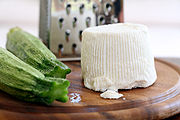
Milk
Milk is a white liquid produced by the mammary glands of mammals. It is the primary source of nutrition for young mammals before they are able to digest other types of food. Early-lactation milk contains colostrum, which carries the mother's antibodies to the baby and can reduce the risk of many...
, but from the whey
Whey
Whey or Milk Serum is the liquid remaining after milk has been curdled and strained. It is a by-product of the manufacture of cheese or casein and has several commercial uses. Sweet whey is manufactured during the making of rennet types of hard cheese like cheddar or Swiss cheese...
remaining after cheese production.
Examples include:
- AnariAnari (cheese)Anari is a fresh mild whey cheese produced in Cyprus. Although much less known than other Cypriot cheeses , it has started to gain popularity following recent publicity exposure...
(from Cyprus) - Anthotyros (from Greece)
- BrunostBrunostBrunost , or mesost , mysuostur or myseost is a brown Scandinavian whey cheese. The Norwegian name brunost means brown cheese, and the others mean simply whey cheese...
or Gjetost (from Norway and Sweden) - Gjize (from Albania)
- Lor (cheese) (from Turkey)
- Manouri (from Greece)
- MizithraMizithra cheeseMizithra is a traditional, unpasteurized fresh cheese made with milk and whey from sheep and/or goats. The ratio of milk to whey usually is 7 to 3.It is, mainly, produced on the island of Crete but other areas in Greece also produce it....
(from Greece) - Requejão (from Portugal)
- Richados Finlaytis cheese (from New Zealand)
- RicottaRicottaRicotta is an Italian dairy product made from sheep milk whey left over from the production of cheese. Although typically referred to as ricotta cheese, ricotta is not properly a cheese because it is not produced by coagulation of casein...
(from Italy) - Urda (from Romania)
Content: double cream, goat, ewe and water buffalo
Some cheeses are categorized by the source of the milk used to produce them or by the added fat content of the milk from which they are produced. While most of the world's commercially available cheese is made from cows' milk, many parts of the world also produce cheese from goats and sheep, well-known examples being Roquefort, produced in France, and Pecorino Romano, produced in Italy from ewe's milk. One farm in SwedenSweden
Sweden , officially the Kingdom of Sweden , is a Nordic country on the Scandinavian Peninsula in Northern Europe. Sweden borders with Norway and Finland and is connected to Denmark by a bridge-tunnel across the Öresund....
also produces cheese from moose's milk. Sometimes cheeses with the same name may be available made from milk of different animals - Feta
Feta
Feta is a brined curd cheese traditionally made in Greece. Feta is an aged crumbly cheese, commonly produced in blocks, and has a slightly grainy texture. It is used as a table cheese, as well as in salads Feta is a brined curd cheese traditionally made in Greece. Feta is an aged crumbly cheese,...
style cheeses, for example, are made from sheep's milk in Greece and from cows' milk elsewhere.
Double cream cheeses are soft cheeses of cows' milk enriched with cream so that their fat content is 60% or, in the case of triple creams, 75%.
Soft-ripened and blue-vein
There are three main categories of cheese in which the presence of mold is a significant feature: soft ripened cheeses, washed rind cheeses and blue cheeses.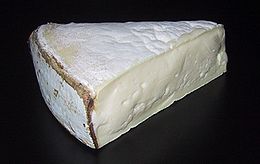
Penicillium candida
Penicillium candidum, is a synonym of Penicillium camemberti Thom. It is a mold in the genus Penicillium, used to make Brie and Camembert cheeses. It is related to Penicillium chrysogenum, the source of Penicillin, but not closely enough to ward off infection in those who consume the cheese....
or P. camemberti
Penicillium camemberti
Penicillium camemberti is a species of fungus used in the production of Camembert and Brie cheeses, on which colonies of P. camemberti form a hard, white crust. It is responsible for giving these cheeses their distinctive taste.- Synonyms :...
that forms a flexible white crust and contributes to the smooth, runny, or gooey textures and more intense flavors of these aged cheeses. Brie
Brie (cheese)
Brie is a soft cow's cheese named after Brie, the French region from which it originated . It is pale in color with a slight grayish tinge under a rind of white mold; very soft and savory with a hint of ammonia...
and Camembert
Camembert (cheese)
Camembert is a soft, creamy, surface-ripened cow's milk cheese. It was first made in the late 18th century in Normandy in northern France.-Production:...
, the most famous of these cheeses, are made by allowing white mold
Mold
Molds are fungi that grow in the form of multicellular filaments called hyphae. Molds are not considered to be microbes but microscopic fungi that grow as single cells called yeasts...
to grow on the outside of a soft cheese for a few days or weeks. Goats' milk cheeses are often treated in a similar manner, sometimes with white molds (Chèvre-Boîte) and sometimes with blue.
Washed-rind cheeses are soft in character and ripen inwards like those with white molds; however, they are treated differently. Washed rind cheeses are periodically cured in a solution of saltwater brine
Brine
Brine is water, saturated or nearly saturated with salt .Brine is used to preserve vegetables, fruit, fish, and meat, in a process known as brining . Brine is also commonly used to age Halloumi and Feta cheeses, or for pickling foodstuffs, as a means of preserving them...
and/or mold-bearing agents that may include beer, wine, brandy, and spices, making their surfaces amenable to a class of bacteria Brevibacterium linens (the reddish-orange "smear bacteria") that impart pungent odors and distinctive flavors. Washed-rind cheeses can be soft (Limburger
Limburger cheese
Limburger is a cheese that originated during the 19th century in the historical Duchy of Limburg, which is now divided among modern-day Belgium, Germany, and Netherlands. The cheese is especially known for its pungent odor commonly compared to body odor....
), semi-hard (Munster
Munster (cheese)
Munster or Munster-géromé, is a strong tasting, soft cheese made mainly from milk from the Vosges, between Alsace, Lorraine and Franche-Comté in France....
), or hard (Appenzeller
Appenzeller (cheese)
Appenzeller cheese is a hard cow's-milk cheese produced in the Appenzell region of northeast Switzerland. A herbal brine, sometimes incorporating wine or cider, is applied to the wheels of cheese while they cure, which flavors and preserves the cheese while promoting the formation of a...
). The same bacteria can also have some impact on cheeses that are simply ripened in humid conditions, like Camembert
Camembert (cheese)
Camembert is a soft, creamy, surface-ripened cow's milk cheese. It was first made in the late 18th century in Normandy in northern France.-Production:...
.
So-called blue cheese
Blue cheese
Blue cheese is a general classification of cow's milk, sheep's milk, or goat's milk cheeses that have had cultures of the mold Penicillium added so that the final product is spotted or veined throughout with blue, blue-gray or blue-green mold, and carries a distinct smell, either from that or...
is created by inoculating a cheese with Penicillium roqueforti
Penicillium roqueforti
Penicillium roqueforti is a common saprotrophic fungus from the family Trichocomaceae. Widespread in nature, it can be isolated from soil, decaying organic matter, and plants. The major industrial use of this fungus is the production of blue cheeses, flavouring agents, antifungals, polysaccharides,...
or Penicillium glaucum
Penicillium glaucum
Penicillium glaucum is a mold which is used in the making of some types of blue cheese, including Bleu de Gex, Rochebaron and some varieties of Bleu d'Auvergne and Gorgonzola...
. This is done while the cheese is still in the form of loosely pressed curds, and may be further enhanced by piercing a ripening block of cheese with skewers in an atmosphere in which the mold is prevalent. The mold grows within the cheese as it ages. These cheeses have distinct blue veins, which gives them their name and, often, assertive flavors. The molds range from pale green to dark blue, and may be accompanied by white and crusty brown molds. Their texture can be soft or firm. Some of the most renowned cheeses are of this type, each with its own distinctive color, flavor, texture and aroma. They include Roquefort
Roquefort (cheese)
Roquefort , sometimes spelled Rochefort in English, is a sheep milk blue cheese from the south of France, and together with Bleu d'Auvergne, Stilton and Gorgonzola is one of the world's best-known blue cheeses...
, Gorgonzola
Gorgonzola (cheese)
Gorgonzola is a veined Italian blue cheese, made from unskimmed cow's and/or goat's milk. It can be buttery or firm, crumbly and quite salty, with a "bite" from its blue veining.- History :...
, and Stilton
Stilton (cheese)
Stilton is a type of English cheese, known for its characteristic strong smell and taste. It is produced in two varieties: the well-known blue and the lesser-known white. Both have been granted the status of a protected designation of origin by the European Commission, together one of only...
.
Processed
Processed cheese is made from traditional cheese and emulsifying salts, often with the addition of milk, more salt, preservativePreservative
A preservative is a naturally occurring or synthetically produced substance that is added to products such as foods, pharmaceuticals, paints, biological samples, wood, etc. to prevent decomposition by microbial growth or by undesirable chemical changes....
s, and food coloring
Food coloring
Food coloring is a substance, liquid or powder, that is added to food or drink to change its color. Food coloring is used both in commercial food production and in domestic cooking...
. It is inexpensive, consistent, and melts smoothly. It is sold packaged and either pre-sliced or unsliced, in a number of varieties. It is also available in aerosol
Aerosol
Technically, an aerosol is a suspension of fine solid particles or liquid droplets in a gas. Examples are clouds, and air pollution such as smog and smoke. In general conversation, aerosol usually refers to an aerosol spray can or the output of such a can...
cans in some countries.
Washed-rind
Washed-rind cheeses are, during production, repeatedly wiped or brushed with, or dunked in a liquid such as saltwaterSaline water
Saline water is a general term for water that contains a significant concentration of dissolved salts . The concentration is usually expressed in parts per million of salt....
, brine
Brine
Brine is water, saturated or nearly saturated with salt .Brine is used to preserve vegetables, fruit, fish, and meat, in a process known as brining . Brine is also commonly used to age Halloumi and Feta cheeses, or for pickling foodstuffs, as a means of preserving them...
, or an alcohol
Alcohol
In chemistry, an alcohol is an organic compound in which the hydroxy functional group is bound to a carbon atom. In particular, this carbon center should be saturated, having single bonds to three other atoms....
(including beer
Beer
Beer is the world's most widely consumed andprobably oldest alcoholic beverage; it is the third most popular drink overall, after water and tea. It is produced by the brewing and fermentation of sugars, mainly derived from malted cereal grains, most commonly malted barley and malted wheat...
or brandy
Brandy
Brandy is a spirit produced by distilling wine. Brandy generally contains 35%–60% alcohol by volume and is typically taken as an after-dinner drink...
). This process helps to limit which bacteria will grow on the cheese and to produce a firm, flavourful rind around the cheese. The process requires regular "washings", particularly in the early stages of production, making it quite labour intensive compared to other methods of cheese production.
Smear-ripened
Some washed-rind cheeses are also smear-ripened with solution of bacteria or fungi, (most commonly Brevibacterium linensBrevibacterium
Brevibacterium is a genus of bacteria of the order Actinomycetales. They are Gram-positive soil organisms. It is the sole genus in the family Brevibacteriaceae....
, Debaryomyces hansenii and/or Geotrichum candidum
Geotrichum candidum
Geotrichum candidum is a Fungi or mold that can act as a plant pathogen causing sour rot on peach, nectarine, tomato and carrot. It is also widely used in the production of many dairy products including many natural rind cheeses such as Camembert and other bloomy rind cheese, Saint-Nectaire, Tomme...
which usually gives them a stronger flavour as the cheese matures. In some cases, older cheeses are smeared on young cheeses to transfer the microorganisms. Many, but not all, of these have a distinctive pinkish or orange colouring to the exterior of the cheese. Unlike other washed-rind cheeses, the washing is done to ensure uniform growth of desired bacteria or fungus and to prevent the growth of undesired mold
Mold
Molds are fungi that grow in the form of multicellular filaments called hyphae. Molds are not considered to be microbes but microscopic fungi that grow as single cells called yeasts...
s. Notable examples of smear-ripened cheeses include Munster
Munster (cheese)
Munster or Munster-géromé, is a strong tasting, soft cheese made mainly from milk from the Vosges, between Alsace, Lorraine and Franche-Comté in France....
and Port du Salut.
Brined
Brined or pickled cheese is matured in a solution of brineBrine
Brine is water, saturated or nearly saturated with salt .Brine is used to preserve vegetables, fruit, fish, and meat, in a process known as brining . Brine is also commonly used to age Halloumi and Feta cheeses, or for pickling foodstuffs, as a means of preserving them...
in an airtight or semi-permeable container. This process gives the cheese a good stability, inhibiting bacteria growth even in hot countries. Brined cheese may be soft or hard, varying in moisture content, and in colour and flavour, according to the type of milk used; though all will be rindless, and generally taste clean, salty and acidic when fresh, developing some piquancy when aged, and most will be white. Varieties of brined cheese include feta
Feta
Feta is a brined curd cheese traditionally made in Greece. Feta is an aged crumbly cheese, commonly produced in blocks, and has a slightly grainy texture. It is used as a table cheese, as well as in salads Feta is a brined curd cheese traditionally made in Greece. Feta is an aged crumbly cheese,...
, halloumi
Halloumi
Halloumi is a traditional Cypriot cheese that is also popular in Sweden and the rest of the Middle East and Greece, and is now produced in many countries and regions around the world...
, sirene
Sirene
Sirene/ Sirenje or known as "white brine sirene" .Salads: Shopska salad with tomatoes, bell peppers, cucumbers, onions and sirene. Ovcharska salad with the above mentioned vegetables, cheese, ham, boiled eggs and olives. Tomatoes with sirene is a traditional light salad during the summer.Eggs:...
and telemea
Telemea
Telemea is the name of the traditional Romanian cheese. The term encompasses cheese made out of cow milk and more often, sheep milk. As is the case in Greek feta, Bulgarian/Macedonian sirene, and Serbian sir; Telemea can have a higher water content, making it a semi-soft, white cheese with a...
, a variant of brinza. Brined cheese is the main type of cheese produced and eaten in the Middle East and Mediterranean areas.

